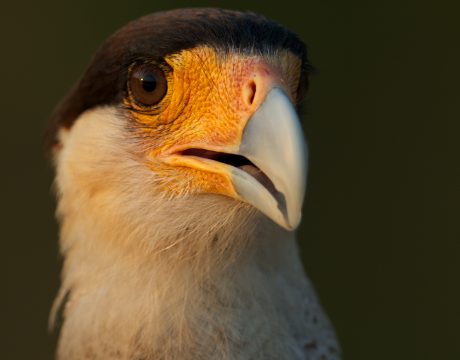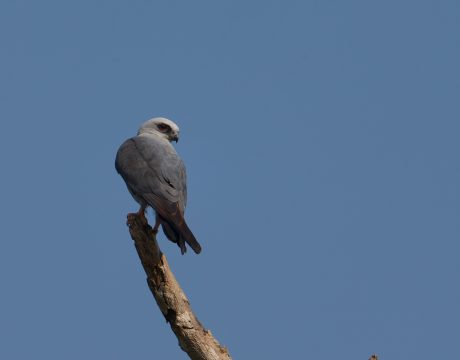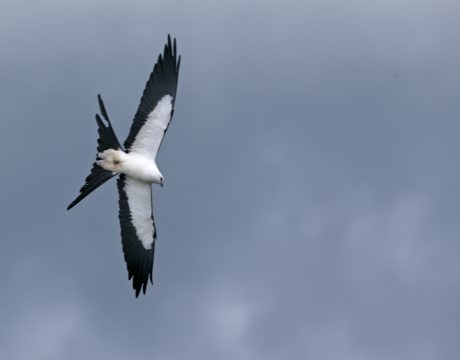Return of Bird of the Week: Chimango Caracara
There are about ten species of Caracara, spread across five genera. Here’s another. The Chimango Caracara is found in the southern half of South America, from southern Brazil to the tip of Argentina. It’s a smaller, somewhat drabber member of the subfamily, and, at least in Tierra del Fuego, fills the ecological niche of ravens and vultures: it’s mostly a scavenger and opportunistic predator, and a generalist, eating everything from bugs to dead cattle. The apparent apron in this photo is a consequence of the strong wind blowing from behind the bird. The wind is usually blowing strongly in Tierra…
Return of Bird of the Week: Striated Caracara
The Striated Caracara is a large, dark raptor, with a wingspan of about four feet, a little larger in the females. It has a very restricted range, limited to islands off extreme southern South America, the Falkland Islands and various islands, mostly to the south of the Beagle Channel and coastal areas of Isla Grande de Tierra del Fuego. It is very dark brownish-black overall, with white stippling on the breast and upper belly, a dark chestnut lower belly and undertail coverts, a white band on the tail, and a yellow cere. It’s found along rocky coasts and nearby open…
Failure as a Conservative art form
Hey kids, it’s Word Thursday! Whether you find it grotesque, or humorous (or both), the transmogrification of Governor Dunleavy from a humble Wasilla man of the people into a self-glorifying Trump wannabe continues before our very eyes. And it’s not really a stretch to say that the governor thinks he’s Tundra Trump because he is literally saying it himself… while gazing meaningfully into the middle-distance. It’s not clear why the State Senator who voted against a budget so he could get thrown out of the caucus so he could justify quitting so he could get an early…
Return of Bird of the Week: Southern Crested Caracara
Caracaras are a subfamily of Falconidae, the same family that includes North America’s falcons. Exactly which subfamily is a matter of some dispute; the taxonomy of Caracaras is unsettled.[^1] Probably the most common Caracara in South America is the Southern Crested Caracara.[^2] The species is somewhat like a Bald Eagle in that it is both a predator and a scavenger. It has almost no fear of humans and bullies Black and Turkey Vultures off of carrion. Its wingspan is a little over four feet but the head and bill, as you can see here, are massive. The talons are pretty…
FACE it – Time for Don Young to go.
TOTALLY NOT WORRIED. NOPE, NOT WORRIED AT ALL… The beleaguered governor who said he “wasn’t worried at all” about the recall effort has spent the last week being “not worried” on national TV and in the White House. The guy who spent most of his political life grousing about “federal overreach” and how those darn DC bureaucrats need to stay out of Alaska’s business is now begging for dollars in the Oval Office. Literally. The schmoozing has resulted an extended meeting in the White House on “personal business” which basically means who knows what the governor has promised or…
Return of Bird of the Week: White-tailed Kite
You can readily see why it is called a White-tailed Kite. The photo also shows those distinctive black shoulders, the two-toned tail and that very distinctive hovering posture. It’s a bit smaller than the other Kites, but still a decent-sized raptor, with a wing span of 42 inches. The populations and even the range of this species has been on a roller-coaster the last 100 years. The species’ preferred habitat is open grasslands and savannah-like habitats. It has benefited somewhat from humankind’s conversion of forests to pasture, but suffered from the conversion of grasslands to monoculture agriculture. It was threatened…
Return of Bird of the Week: Plumbeous Kite
WC is continuing with kites, mid-sized raptors, not the human-made flying objects named after the birds. This week we’ll have a look at the Plumbeous Kite. The Plumbeous Kite takes its name from its dark gray, well, leaden color. “Plumbeous” is from the Latin for “lead.” It’s quite similar in appearance to the Mississippi Kite, which shares its range in migration and during the winter. It ranges from northern Mexico to northern Argentina. It feeds on insects from a perch or while in flight over the forest, particularly over the canopy or along edges. Some Plumbeous Kites also follow primates…
Return of Bird of the Week: Snail Kite
Non-birders are always surprised to learn there is a large raptor whose primary prey is . . . snails. It somehow doesn’t fit the image of a raptor: a fast-flying, fierce predator that subsists primarily on famously slow-moving mollusks. But that long, hooked upper mandible has evolved to hook the snail out of its shell. Voila! Escargot! Snail Kites are also a bit unusual in that they are sexually dimorphic. Females have a dark brown back and a heavily streaked chest, brown on white, with lots of white on the head. Males look very different. The backlighting in the photo…
Return of Bird of the Week: Swallow-tailed Kite
As promised, WC will take a break from Tanagers for a while, and spend some time with bigger birds instead. Specifically, with Accipitridae, the world-wide family of birds sometimes called raptors, and at least to start, with Kites. When WC was just getting started in birding, it was a shock to learn that “kite” isn’t a specific family of birds, or even a single genus. It’s a catch-all lay term for medium- to small-sized raptors with pointy wings. “Hawks” and “falcons” refer to specific related groups; “kites” are just hawks with a different name. We’ll start with the very handsome,…














